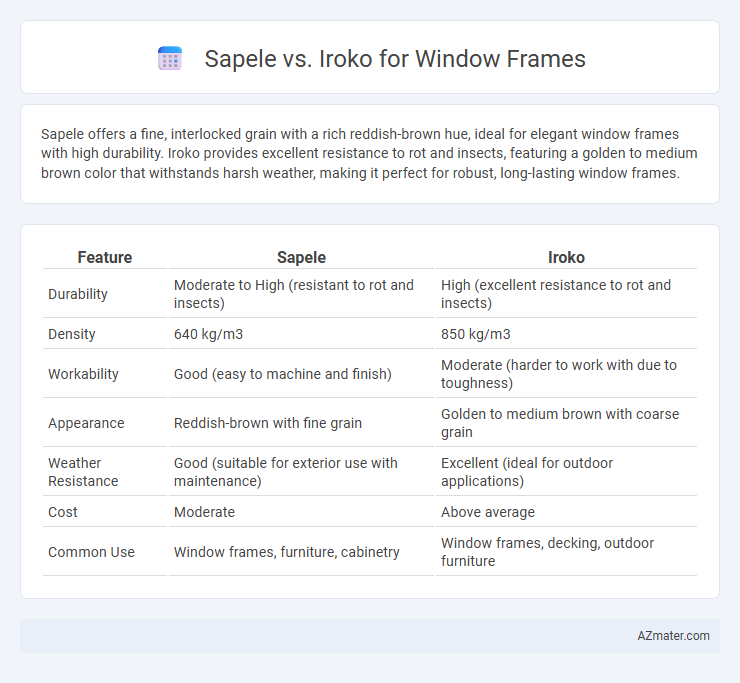Sapele offers a fine, interlocked grain with a rich reddish-brown hue, ideal for elegant window frames with high durability. Iroko provides excellent resistance to rot and insects, featuring a golden to medium brown color that withstands harsh weather, making it perfect for robust, long-lasting window frames.
Table of Comparison
| Feature | Sapele | Iroko |
|---|---|---|
| Durability | Moderate to High (resistant to rot and insects) | High (excellent resistance to rot and insects) |
| Density | 640 kg/m3 | 850 kg/m3 |
| Workability | Good (easy to machine and finish) | Moderate (harder to work with due to toughness) |
| Appearance | Reddish-brown with fine grain | Golden to medium brown with coarse grain |
| Weather Resistance | Good (suitable for exterior use with maintenance) | Excellent (ideal for outdoor applications) |
| Cost | Moderate | Above average |
| Common Use | Window frames, furniture, cabinetry | Window frames, decking, outdoor furniture |
Introduction to Sapele and Iroko for Window Frames
Sapele and Iroko are two popular hardwoods commonly used for window frames due to their durability and aesthetic appeal. Sapele offers a fine grain with a rich reddish-brown color that darkens over time, making it ideal for elegant and modern window designs. Iroko, often called African teak, features a golden to medium brown hue with excellent resistance to weather and decay, providing long-lasting performance in exterior window applications.
Botanical Origins and Wood Characteristics
Sapele (Entandrophragma cylindricum) is an African hardwood known for its rich reddish-brown color and fine interlocked grain, providing excellent dimensional stability and natural resistance to rot, making it ideal for window frames. Iroko (Milicia excelsa) originates from West Africa, exhibiting a golden to medium brown hue with a coarse, uneven texture and high durability, often compared to teak for its weather resistance and strength. Both woods possess natural oils that enhance their decay resistance, but Sapele's tighter grain offers more refined finishes, while Iroko delivers superior toughness and resilience in harsh outdoor conditions.
Durability and Weather Resistance Comparison
Sapele and Iroko are both durable hardwoods commonly used for window frames, but Iroko generally offers superior weather resistance due to its natural oils that provide excellent protection against moisture and decay. Sapele, while strong and dense, is less resistant to prolonged exposure to harsh weather conditions and may require more frequent maintenance or treatment. In environments with high humidity or heavy rainfall, Iroko frames tend to maintain structural integrity longer and resist warping better than Sapele.
Aesthetic Differences: Color and Grain Patterns
Sapele window frames exhibit a rich, reddish-brown hue with a distinctive interlocking grain that produces a fine, ribbon-like pattern, offering a luxurious and elegant appearance. Iroko features a golden to medium brown color with a coarse, somewhat irregular grain that can display occasional dark streaks, creating a more rustic and natural look. The choice between Sapele and Iroko for window frames depends on preference for either the warm, consistent, and refined texture of Sapele or the robust, varied, and earthy aesthetic of Iroko.
Workability and Ease of Fabrication
Sapele offers superior workability for window frames due to its fine, even texture and natural luster, making it easier to plane, cut, and sand compared to Iroko, which is coarser and harder. Iroko, while tougher, presents challenges in nailing and screwing because of its density and interlocked grain, but its natural resistance to decay can reduce finishing time. Both woods respond well to adhesives and finishes, but Sapele's smoother surface enables quicker and more precise fabrication in detailed joinery.
Cost and Availability in the Market
Sapele and Iroko are both popular hardwoods for window frames, with Iroko generally costing more due to its higher durability and resistance to weathering. Sapele is more widely available in the market, often making it a cost-effective choice for large projects or budget-conscious buyers. While Iroko's price is justified by longer lifespan and strength, Sapele remains a preferred option for affordability and easier procurement.
Maintenance Requirements Over Time
Sapele window frames demand regular oiling and sealing to prevent drying and warping, ensuring long-term durability with moderate upkeep. Iroko exhibits natural resistance to rot and insect damage, requiring less frequent maintenance but benefits from periodic cleaning and occasional oiling to retain its rich color and structural integrity. Both hardwoods perform well over time, but Iroko's maintenance involves less consistent intervention compared to Sapele's more proactive care regime.
Sustainability and Environmental Impact
Sapele and Iroko are both tropical hardwoods commonly used for window frames, but Sapele is generally considered more sustainable due to its faster growth and availability from responsibly managed forests. Iroko, while durable and resistant to decay, is often sourced from regions with less rigorous environmental regulations, raising concerns about deforestation and habitat loss. Choosing Sapele from certified plantations helps reduce ecological impact and supports sustainable forestry practices.
Suitability for Different Architectural Styles
Sapele wood offers a fine, uniform texture and rich reddish-brown hue, making it ideal for traditional and colonial architectural styles where warm tones and intricate detailing are valued. Iroko's durability and coarse grain with golden to dark brown color suit contemporary and tropical designs that demand robust, weather-resistant window frames with natural aesthetic appeal. Both woods provide excellent structural integrity, but Sapele enhances elegance in classic settings, while Iroko supports a more rustic, modern appearance.
Final Recommendation: Which Wood for Your Window Frame?
Sapele offers a rich reddish-brown color with a fine, uniform grain that provides an elegant finish and good durability for window frames, while Iroko is known for its exceptional resistance to rot, insect attacks, and weather, featuring a yellow to golden brown hue that darkens over time. For window frames exposed to harsh outdoor conditions, Iroko is the superior choice due to its longevity and low maintenance requirements. However, if aesthetic appeal with a smoother texture is a priority, Sapele delivers a refined look ideal for interior or moderately exposed frames.

Infographic: Sapele vs Iroko for Window Frame
 azmater.com
azmater.com